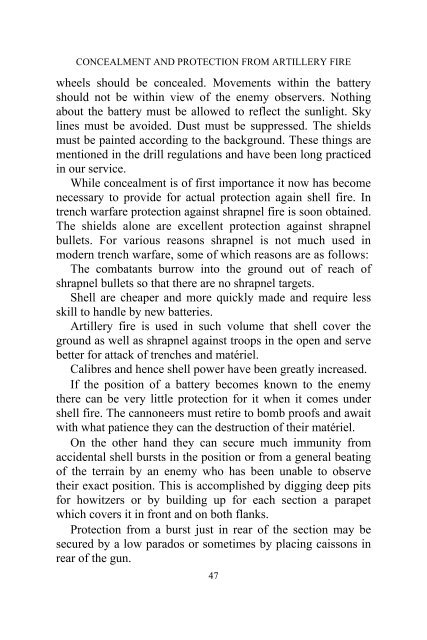the field artillery journal - Fort Sill - U.S. Army
the field artillery journal - Fort Sill - U.S. Army
the field artillery journal - Fort Sill - U.S. Army
Create successful ePaper yourself
Turn your PDF publications into a flip-book with our unique Google optimized e-Paper software.
CONCEALMENT AND PROTECTION FROM ARTILLERY FIRE<br />
wheels should be concealed. Movements within <strong>the</strong> battery<br />
should not be within view of <strong>the</strong> enemy observers. Nothing<br />
about <strong>the</strong> battery must be allowed to reflect <strong>the</strong> sunlight. Sky<br />
lines must be avoided. Dust must be suppressed. The shields<br />
must be painted according to <strong>the</strong> background. These things are<br />
mentioned in <strong>the</strong> drill regulations and have been long practiced<br />
in our service.<br />
While concealment is of first importance it now has become<br />
necessary to provide for actual protection again shell fire. In<br />
trench warfare protection against shrapnel fire is soon obtained.<br />
The shields alone are excellent protection against shrapnel<br />
bullets. For various reasons shrapnel is not much used in<br />
modern trench warfare, some of which reasons are as follows:<br />
The combatants burrow into <strong>the</strong> ground out of reach of<br />
shrapnel bullets so that <strong>the</strong>re are no shrapnel targets.<br />
Shell are cheaper and more quickly made and require less<br />
skill to handle by new batteries.<br />
Artillery fire is used in such volume that shell cover <strong>the</strong><br />
ground as well as shrapnel against troops in <strong>the</strong> open and serve<br />
better for attack of trenches and matériel.<br />
Calibres and hence shell power have been greatly increased.<br />
If <strong>the</strong> position of a battery becomes known to <strong>the</strong> enemy<br />
<strong>the</strong>re can be very little protection for it when it comes under<br />
shell fire. The cannoneers must retire to bomb proofs and await<br />
with what patience <strong>the</strong>y can <strong>the</strong> destruction of <strong>the</strong>ir matériel.<br />
On <strong>the</strong> o<strong>the</strong>r hand <strong>the</strong>y can secure much immunity from<br />
accidental shell bursts in <strong>the</strong> position or from a general beating<br />
of <strong>the</strong> terrain by an enemy who has been unable to observe<br />
<strong>the</strong>ir exact position. This is accomplished by digging deep pits<br />
for howitzers or by building up for each section a parapet<br />
which covers it in front and on both flanks.<br />
Protection from a burst just in rear of <strong>the</strong> section may be<br />
secured by a low parados or sometimes by placing caissons in<br />
rear of <strong>the</strong> gun.<br />
47

















